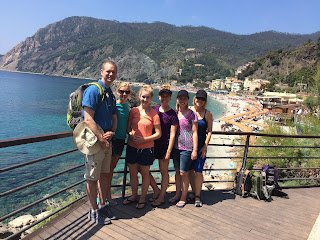When I was little, I didn't really like the idea of the Medieval time period. My mom once took us four girls on a field trip to "Medieval Times," where we watched an educational jousting show while we were served a meal. It was a very interactive trip, and I would definitely recommend it. But, at the time, I wasn't impressed. Perhaps it was because we were served chicken with no forks, forcing me to eat with my hands. Or maybe it was because the idea of jousting seemed weird. Either way, I never would have imagined that I would later have the opportunity to actually visit real medieval towns in Germany. This time around, I appreciated it a whole lot more.
We had the opportunity to travel on the Romantic Road and visit several towns along the way. It was amazing to walk on the old city walls and stand in the towers where the guards kept watch. Each city was different, but they all had one thing in common. Whenever we looked out over the city, it was a sea of red rooftops! They were required to use shingles to help prevent fires.
 |
| The red rooftops were everywhere! |
 |
| Walking along the original city wall! |
One of our favorite stops was the city of Rothenburg, Germany. We absolutely loved walking around, admiring the shops, and learning about life during the Medieval times. Their buildings, for instance, were constructed quite differently. The houses all had huge doors so that a carriage could fit through, but they usually included a smaller door for people. The richer houses even had bells that you could pull instead of knocking.
Crime and punishment also looked very different. They often used torture to bring about a confession from those who were accused of crimes. And, you could be punished for a variety of different things, like drinking coffee, making bread too small or too large if you sold it in a bakery, or quarreling. These crimes had all sorts of punishments, including wearing shame masks. One of the most humourous punishment was the double-neck violin. Quarrelsome women would wear this until they could work out their difficulties.
 |
| A double-neck violin with holes for the head and hands |
Even though we personally wouldn't like living during this time period, we still enjoyed learning about it and spending time in the cities. We also got to celebrate Father's Day in Rothenburg, even though Germans celebrate it a month earlier. Each city was simply charming, and I will miss all the cute houses, flowers in the windows, and cobblestone streets.
 |
| Father's Day dinner |
 |
| The streets were adorable! |






































